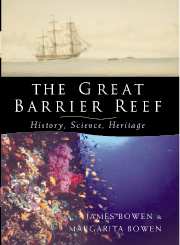Book contents
- Frontmatter
- Contents
- Abbreviations and Acronyms
- Preface
- Acknowledgments
- Introduction: An Overview
- Part One NAVIGATORS AND NATURALISTS IN THE AGE OF SAIL
- Chapter 1 QUEST FOR THE GREAT SOUTH LAND
- Chapter 2 VOYAGE OF THE ENDEAVOUR: COOK AND THE ‘LABYRINTH’
- Chapter 3 ENDEAVOUR NATURALISTS: ‘A SEPARATE CREATION’
- Chapter 4 MATTHEW FLINDERS: VOYAGE OF THE INVESTIGATOR
- Chapter 5 THE REEF EXPLORED: EARLY SURVEYS, 1821–1844
- Chapter 6 EARLY REEF CHARTS COMPLETED: 1846–1862
- Chapter 7 THE REEF AS A MARITIME HIGHWAY: COLONY OF QUEENSLAND, 1859–1900
- Chapter 8 FROM NATURAL HISTORY TO SCIENCE, 1850–1900: VOYAGES OF THE CHALLENGER AND THE CHEVERT
- Chapter 9 EXPLOITATION AND RESOURCE RAIDING: 1860–1890
- Chapter 10 FOR MAXIMUM YIELD: REEF BIOLOGY
- Part Two A NEW ERA IN REEF AWARENESS: FROM EARLY SCIENTIFIC INVESTIGATION TO CONSERVATION AND HERITAGE
- References
- Index
Chapter 10 - FOR MAXIMUM YIELD: REEF BIOLOGY
from Part One - NAVIGATORS AND NATURALISTS IN THE AGE OF SAIL
Published online by Cambridge University Press: 22 September 2009
- Frontmatter
- Contents
- Abbreviations and Acronyms
- Preface
- Acknowledgments
- Introduction: An Overview
- Part One NAVIGATORS AND NATURALISTS IN THE AGE OF SAIL
- Chapter 1 QUEST FOR THE GREAT SOUTH LAND
- Chapter 2 VOYAGE OF THE ENDEAVOUR: COOK AND THE ‘LABYRINTH’
- Chapter 3 ENDEAVOUR NATURALISTS: ‘A SEPARATE CREATION’
- Chapter 4 MATTHEW FLINDERS: VOYAGE OF THE INVESTIGATOR
- Chapter 5 THE REEF EXPLORED: EARLY SURVEYS, 1821–1844
- Chapter 6 EARLY REEF CHARTS COMPLETED: 1846–1862
- Chapter 7 THE REEF AS A MARITIME HIGHWAY: COLONY OF QUEENSLAND, 1859–1900
- Chapter 8 FROM NATURAL HISTORY TO SCIENCE, 1850–1900: VOYAGES OF THE CHALLENGER AND THE CHEVERT
- Chapter 9 EXPLOITATION AND RESOURCE RAIDING: 1860–1890
- Chapter 10 FOR MAXIMUM YIELD: REEF BIOLOGY
- Part Two A NEW ERA IN REEF AWARENESS: FROM EARLY SCIENTIFIC INVESTIGATION TO CONSERVATION AND HERITAGE
- References
- Index
Summary
Throughout the three pearling decades of the late nineteenth century the major problem confronting the industry was continuing fluctuations in supply as beds became exhausted by the depredations of resource raiding, for which the Japanese had become the prime targets of abuse. The problem, however, was much more systemic. Ship owners wanted the best possible return from each venture and to that end developed the bonus incentive for higher yields described earlier. Following the first serious decline in the late 1870s the industry was stimulated when new fields near Badu, but also stretching to New Guinea, known as the ‘Old Ground’, were discovered in 1881. Again these were raided and by 1885 were so depleted that many of the luggers, and their schooner ‘mother ships’, left for new fields off Broome in Western Australia. As the larger shells had virtually disappeared, smaller and smaller sizes were harvested, down to 5 inches internal nacre measurement, which made them ‘practically valueless [since] … no workable mother-of-pearl or nacre is left’ (Saville-Kent 1890a:4).
Queensland had attempted its first regulation in 1881 with the Pearl-Shell and Bêchede-Mer Fishery Act, the same year that New South Wales, concerned over depletion of its table fish stocks, established the Macleay Royal Commission that recommended controls. Both colonies found that legislation was easy, enforcement difficult. In the pearling grounds, consequently, further decline continued as both quantities, and quality, fell.
- Type
- Chapter
- Information
- The Great Barrier ReefHistory, Science, Heritage, pp. 155 - 170Publisher: Cambridge University PressPrint publication year: 2002

